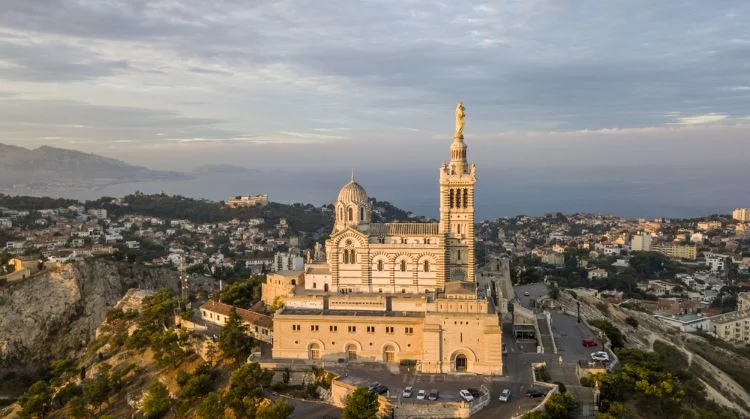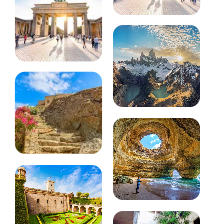Visit and discovery of Notre-Dame de la Garde in Marseille

Perched on top of a hill 150 m above sea level, Notre-Dame de la Garde has watched over the city and its inhabitants since the 13th century. I’d better warn you right away that this symbol, so dear to the hearts of the people of Marseilles, has to be earned! To reach the building, you’ll need strong calves and good shoes to climb the slopes, which can reach 14% depending on the route you take, especially if you’re with young children. However, if you want to keep your holiday a holiday, you can also take the bus or the little tourist train to get there! Whichever way you choose to get to the right mother, one thing is certain: you can’t spend a holiday in Marseille without visiting Notre-Dame de la Garde!
Prices, opening times, access, guided tours, all the practical information you need about Notre-Dame de la Garde
Rate
Visits to Notre-Dame de la Garde are completely free of charge. If you wish to contribute to the upkeep of the building, you will find trunks in the building, as in all religious buildings, into which you can slip a donation.
If you use a tour guide, you will of course have to pay to visit with him or her.
Opening hours of Notre-Dame de la Garde
The Basilica of Notre-Dame de la Garde is open every day from 7am to 6.15pm in low season and 7.15pm in high season.
How do I get to the Basilica of Notre-Dame de la Garde?
Here’s how to visit Notre-Dame de la Garde :
1 – On foot
- Via the Puget hill garden from the Old Port. It’s a good climb, but you can stop halfway up in the park.
- Via boulevard André Aune from the Vieux-Port. Quite a challenging route.
- Via Vauban from the Vieux-Port, but be careful, the climb is quite steep at the end!
- Take the Roucas-Blanc route from the Old Port via the Quai de Rive Neuve. This old pilgrimage route has the advantage of taking you through the typical districts of Marseille.
2 – By bus
Line 60 takes you directly to the Basilica.
3 – With Marseille’s tourist train
The little tourist train departs from the Vieux-Port and takes you on a tour of the Corniche, the seafront and legendary sites such as Fort Saint-Jean, Fort Saint-Nicolas, the Palais du Pharo, Abbaye St Victor, a superb view of the Pont de la Fausse Monnaie, Château Valmer and the famous Vallon des Auffes.
In the distance, you’ll see the Frioul islands and the Château d’If. The train will then head for the Vallon de l’Oriol, where you’ll discover some magnificent “Marseille-style” hillside residences.
Departures every 20 minutes in high season and every 40 minutes in low season.

Why visit Notre-Dame de la Garde?
- It is the emblem of Marseille, Marseille without the good mother is no longer Marseille, she has watched over the city and the people of Marseille for 8 centuries.
- Millions of visitors are attracted every year by its beauty, its presence, its history and, of course, as a place of worship.
- From the top of the colline de la Garde, you can enjoy an exceptional 360° panoramic view of the city of Marseille. Lovers of landscapes and photos will have plenty to look at and images to add to their albums of memories!
- For its neo-Romanesque architecture adorned with Byzantine-inspired mosaics.
- The statue of the Good Mother is a magnificent golden statue of the Virgin Mary, 11.20 m high and weighing almost 1 tonne.
- Admire the white Carrara marble, red Brignoles marble and Byzantine-style mosaics that adorn the interior of the Basilica of Notre-Dame de la Garde.
What is the history of Notre-Dame de la Garde?
In 1214, a Marseille priest called Pierre had a shrine built dedicated to the Virgin Mary. Sailors were very attached to this place, where they came to pray when they had escaped shipwreck. As more and more pilgrims came to pray and ask for the Virgin’s protection, another chapel was built in the 15th century, followed by a surrounding fort under FrancisI, to protect them from the assaults of the Emperor Charles V.
During the Revolution, the fort was turned into a prison and worship was banned. The revolutionaries looted, sold or destroyed all the liturgical objects, ex-voto items, paintings, crosses, etc. The place did not become a place of worship again until 1807.
The Basilica of Notre-Dame de la Garde as you know it today began to take shape in 1850. Once again, the site had become too small to accommodate all the believers, bearing in mind that it had also become a place of pilgrimage to fight cholera. Monseigneur de Mazenod therefore decided to build a Basilica, and construction began in 1853 to plans drawn up by the architect Henry-Jacques Espérandieu.
It took over 40 years to build this edifice:
- The nave is 32.7 metres long and 14 metres wide,
- Side chapels 3.8 metres by 5.4 metres.
The statue of the Virgin Mary is enthroned at the highest point of the basilica, and her gaze, turned towards the sea, protects the city of Marseilles and its sailors. The attachment of the people of Marseilles to their good mother can be seen in the number of ex-voto offerings in the basilica (plaques, paintings, models, etc.) in thanks for an answered prayer. Unfortunately, many of these testimonies to the past were ransacked or sold by the revolutionaries. But post-revolutionary epidemics, wars and shipwrecks have covered the walls with these new tokens of thanks.
Did you know?
- The statue of the Virgin was made by the Christofle company using a completely new process in the 19th century: electroplating. The four sections were made using latex moulds, and the copper was electroplated onto them.
- Around thirty years ago, it was still possible to climb to the top of the statue by a staircase and see Marseille through its eyes. A privilege that can only be glimpsed today through photographs…
200 audioguided tours for cities all around the world
Download
